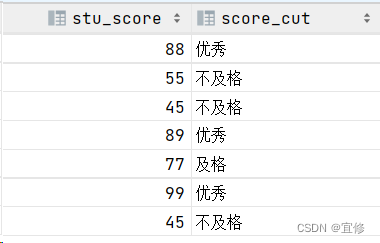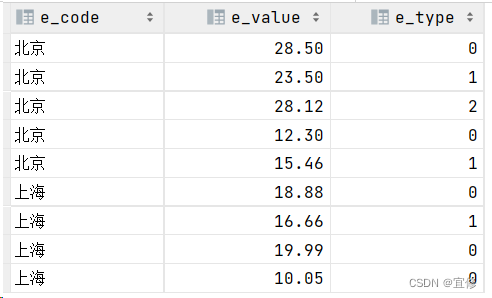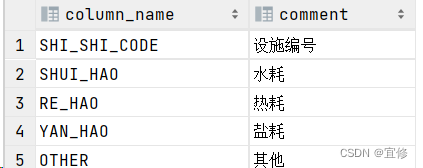目錄
4.1 If函數語法格式
4.2 CASE WHEN 條件表達式格式
4.3 update與 case when
4.4 練習題1
4.5 練習題2
4.6 練習題3-行轉列
4.7 牛客練習題
4.8 LeetCode練習題
4.1 If函數語法格式
IF(expr1,expr2,expr3)解釋:
如果表達式expr1=true(expr1 <> 0 and expr1 <> NULL),返回expr2,否則返回expr3,IF() 的返回值為數字值或字符串值,具體情況視其所在語境而定。
常用示例:
expr1參數為1,結果為真,返回正確
select if(1,'正確','錯誤');結果:

4.2 CASE WHEN 條件表達式格式
1. 格式1:簡單case函數
**簡單CASE函數**
CASE 條件參數名稱WHEN 參數值1 THEN '顯示值1'WHEN 參數值2 THEN '顯示值2'...
ELSE '顯示其他值' END2. 格式2:case搜索函數
CASE WHEN condition THEN result[WHEN...THEN...]
ELSE result
ENDcondition是一個返回布爾類型的表達式,
如果表達式返回true,則整個函數返回相應result的值,
如果表達式皆為false,則返回ElSE后result的值,
如果省略了ELSE子句,則返回NULL。
4.3 update與 case when
當我們有時候要更新 數據庫中 同一個字段 根據不同情況更新不同的值,可以用
update Table set field = (case XX when XXXX then XXXwhen xxxx then xxxxxxelse xxxx end)4.4 練習題1
數據庫
drop table if exists `students`;
create table students
(stu_code varchar(10) null,stu_name varchar(10) null,stu_sex int null,stu_score int null
);
# 其中stu_sex字段,0表示男生,1表示女生。
INSERT INTO students (stu_code, stu_name, stu_sex, stu_score) VALUES ('xm', '小明', 0, 88);
INSERT INTO students (stu_code, stu_name, stu_sex, stu_score) VALUES ('xl', '夏磊', 0, 55);
INSERT INTO students (stu_code, stu_name, stu_sex, stu_score) VALUES ('xf', '曉峰', 0, 45);
INSERT INTO students (stu_code, stu_name, stu_sex, stu_score) VALUES ('xh', '小紅', 1, 89);
INSERT INTO students (stu_code, stu_name, stu_sex, stu_score) VALUES ('xn', '小妮', 1, 77);
INSERT INTO students (stu_code, stu_name, stu_sex, stu_score) VALUES ('xy', '小一', 1, 99);
INSERT INTO students (stu_code, stu_name, stu_sex, stu_score) VALUES ('xs', '小時', 1, 45);
場景1-不同狀態下展示為不同的值
題目:
現在學校想要根據學生分數(stu_score)劃分等級,score<60返回不及格,score>=60返回及格,score>=80返回優秀。請返回學生的分數(stu_score)和等級(score_cut)
根據示例,你的查詢應返回以下結果:

SQL代碼:
select stu_score,case when stu_score<60 then '不及格'when stu_score>=60 and stu_score<80 then '及格'when stu_score>=80 then '優秀'end as 'score_cut'
from students;場景2- 統計不同狀態下的值
現老師要統計班中,有多少男同學,多少女同學,并統計男同學中有幾人及格,女同學中有幾人及格,要求用一個SQL輸出結果。其中stu_sex字段,0表示男生,1表示女生。
根據示例,你的查詢應返回以下結果:

select case when stu_sex=0 then '男'when stu_sex=1 then '女'end 'gender',count(*) as 'count_stu',sum(if(stu_score>=60,1,0)) as 'pass'
from students
group by gender;場景3- update與case when相結合
請你編寫一個解決方案來交換所有的 '男' 和 '女' (即,將所有 '女' 變為 '男' ,反之亦然),僅使用 單個 update 語句 ,且不產生中間臨時表。其中stu_sex字段,0表示男生,1表示女生。
注意,你必須僅使用一條 update 語句,且 不能 使用 select 語句。
根據示例,你的查詢應返回以下結果:

update students set stu_sex=(case stu_sex when 0 then 1when 1 then 0end);4.5 練習題2
數據庫
drop table if exists `energy_test`;
drop table if exists `p_price`;-- auto-generated definition
create table energy_test
(e_code varchar(2) null,e_value decimal(5, 2) null,e_type int null
);# 其中,E_TYPE表示能耗類型,0表示水耗,1表示電耗,2表示熱耗
INSERT INTO energy_test (e_code, e_value, e_type) VALUES ('北京', 28.50, 0);
INSERT INTO energy_test (e_code, e_value, e_type) VALUES ('北京', 23.50, 1);
INSERT INTO energy_test (e_code, e_value, e_type) VALUES ('北京', 28.12, 2);
INSERT INTO energy_test (e_code, e_value, e_type) VALUES ('北京', 12.30, 0);
INSERT INTO energy_test (e_code, e_value, e_type) VALUES ('北京', 15.46, 1);
INSERT INTO energy_test (e_code, e_value, e_type) VALUES ('上海', 18.88, 0);
INSERT INTO energy_test (e_code, e_value, e_type) VALUES ('上海', 16.66, 1);
INSERT INTO energy_test (e_code, e_value, e_type) VALUES ('上海', 19.99, 0);
INSERT INTO energy_test (e_code, e_value, e_type) VALUES ('上海', 10.05, 0);-- auto-generated definition
create table p_price
(p_price decimal(5, 2) null comment '價格',p_level int null comment '等級',p_limit int null comment '閾值'
)comment '電能耗單價表';INSERT INTO p_price (p_price, p_level, p_limit) VALUES (1.20, 0, 10);
INSERT INTO p_price (p_price, p_level, p_limit) VALUES (1.70, 1, 30);
INSERT INTO p_price (p_price, p_level, p_limit) VALUES (2.50, 2, 50);
energy_test

p_price

場景1 - 配合聚合函數做統計
現要求統計各個城市,總共使用了多少水耗、電耗、熱耗,使用一條SQL語句輸出結果 有能耗表如下:其中,E_TYPE表示能耗類型,0表示水耗,1表示電耗,2表示熱耗
根據示例,你的查詢應返回以下結果:

select e_code,sum(if(e_type=0,e_value,0)) as '水耗',sum(if(e_type=1,e_value,0)) as '電耗',sum(if(e_type=2,e_value,0)) as '熱耗'
from energy_test
group by e_code;場景2-使用子查詢
根據城市用電量多少,計算用電成本。假設電能耗單價分為三檔,根據不同的能耗值,使用相應價格計算成本。 P_limit為每個檔次的上限。當能耗值(e_value)小于10時,使用P_LEVEL=0時的P_PRICE的值,能耗值大于10小于30使用P_LEVEL=1時的P_PRICE的值…
根據示例,你的查詢應返回以下結果:

select e_code,e_value,case when e_value<(select p_limit from p_price where p_level=0) then (select p_price from p_price where p_level=0)when e_value>=(select p_limit from p_price where p_level=0) and e_value<(select p_limit from p_price where p_level=1) then (select p_price from p_price where p_level=1)when e_value>=(select p_limit from p_price where p_level=1) then (select p_price from p_price where p_level=2)end as 'price'
from energy_test
where e_type=1;4.6 練習題3-行轉列
數據庫
drop table if exists `user_col_comments`;-- auto-generated definition
create table user_col_comments
(column_name varchar(50) null comment '列名',comment varchar(100) null comment '列的備注'
);INSERT INTO user_col_comments (column_name, comment) VALUES ('SHI_SHI_CODE', '設施編號');
INSERT INTO user_col_comments (column_name, comment) VALUES ('SHUI_HAO', '水耗');
INSERT INTO user_col_comments (column_name, comment) VALUES ('RE_HAO', '熱耗');
INSERT INTO user_col_comments (column_name, comment) VALUES ('YAN_HAO', '鹽耗');
INSERT INTO user_col_comments (column_name, comment) VALUES ('OTHER', '其他');
問題:將上表的行列進行轉換顯示
根據示例,你的查詢應返回以下結果:

select max(if(column_name='SHI_SHI_CODE',comment,'')) as 'SHI_SHI_CODE',max(if(column_name='YAN_HAO',comment,'')) as 'YAN_HAO',max(if(column_name='RE_HAO',comment,'')) as 'RE_HAO',max(if(column_name='SHUI_HAO',comment,'')) as 'SHUI_HAO',max(if(column_name='OTHER',comment,'')) as 'OTHER'
from user_col_comments;4.7 牛客練習題
SQL26 - 計算25歲以上和以下的用戶數量
4.8 LeetCode練習題
-
LeetCode_1873. 計算特殊獎金
-
LeetCode_627. 變更性別
-
LeetCode_608. 樹節點
-
LeetCode_1393. 股票的資本損益
)




 響應式詳解)

)

)





)



-minikube的使用)